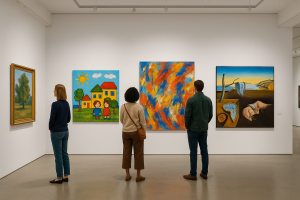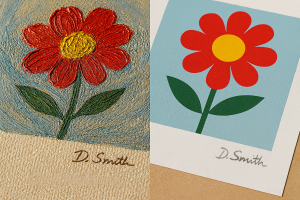If you are interested in art, it is important to understand the difference between lithography, silkscreen printing and original artwork. These three terms are central in the art world. While they may sound familiar, the differences between them – and how they affect an artwork’s value – are not always clear. This guide will explain in a simple and clear way what sets lithography, silkscreen printing and original artwork apart, so you can make an informed choice for your next purchase.
Original Artwork – One of a Kind and Highly Valued
An original artwork is a piece created entirely by the artist’s own hand – whether it is a painting, drawing, collage or sculpture. Every brushstroke, every line and every layer of paint is made directly by the artist, and no identical copy exists anywhere in the world.
This uniqueness gives the work significant artistic and financial value. In most cases, an original will be more expensive, but for collectors and art lovers it is considered “the real thing.”
Lithography
Lithography is a traditional printing technique invented in the late 18th century. The artist draws on a stone or metal plate, and the ink adheres only to the drawn areas. Using a press, the image is transferred to paper, producing a limited series of prints – each one numbered and hand-signed by the artist.
An important distinction between lithography and a regular poster lies in print quality, collectable value and the fact that lithographs are created in limited editions.
Silkscreen Printing
Silkscreen printing (also known as serigraphy) uses a stretched fabric mesh, with each color applied separately onto paper or canvas. This is a meticulous process that can involve dozens of color layers. The prints are produced in limited, numbered editions, and are hand-signed by the artist.
What sets silkscreen prints apart from other methods is the richness of color, depth of texture and the ability to retain a vibrant, lasting appearance over time.
Limited Edition – How It Relates to Lithography, Silkscreen and Originals
In both lithography and silkscreen printing, the number of copies is known in advance and indicated on the work (for example: 25/150 – the 25th print out of 150).
The smaller the edition, the higher the potential value of each piece.
Special markings you may encounter:
-
A.P (Artist’s Proof) – A copy intended for the artist.
-
P.P (Printer’s Proof) – A copy for the printer.
-
E.P (Épreuve d’Artiste) – French term equivalent to A.P.
These copies are usually not numbered but marked with the initials, and are often rare and highly sought after by collectors.
How to Choose Between Lithography, Silkscreen Printing and Original Art
If you want a completely unique piece, an original artwork is the safest choice.
If you prefer owning a work by a well-known artist at a more affordable price, a high-quality limited edition print – whether lithography or silkscreen – is an excellent option.
Both types can hold artistic and collectable value, as long as they are authentic and come from a trusted source.
Conclusion – The Main Differences
The difference between lithography, silkscreen printing and original artwork lies in the creation process, the number of copies and the collectable value. Understanding these differences will help you choose wisely, enjoy your art for years to come and own a piece with true artistic and investment significance.





